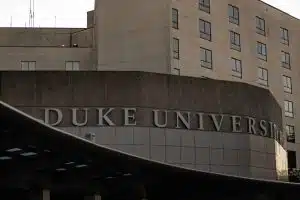Yale Acceptance Rate: Admissions Statistics
What is Yale’s Acceptance Rate?
What is Yale’s acceptance rate? The Yale acceptance rate for the Class of 2027 stood at a record low of 4.5%, reflecting the university’s highly selective and competitive nature. Out of an unprecedented applicant pool of 52,303 hopefuls – the largest in the college’s history – only 2,275 students were admitted.
This figure not only underscores the intense competition to secure a spot at one of the world’s most prestigious institutions but also highlights Yale’s commitment to maintaining a small, intimate educational environment. The exceptionally low acceptance rate is a testament to the caliber of applicants Yale attracts and the rigorous standards it upholds in its admissions process.
Early Action and Early Decision
Yale University offers Early Action (EA) as an application option. For the Class of 2028, the Early Action acceptance rate was 10%.
Here are the Early Action (EA) acceptance rates for Yale University for the last five years:
| Class | EA |
| 2028 | 10% |
| 2027 | 10% |
| 2026 | 10.9% |
| 2025 | 13.8% |
| 2024 | 13.8% |
Yale Acceptance Rate Trends
The acceptance rate at Yale University has seen a notable downward trend over the past decade, emphasizing its increasingly selective nature. So, let’s examine the Yale acceptance rate trends over the past ten years.
| Year Entered | Class of | Total Applications | Yale Acceptance Rate |
| 2014 | 2018 | 30,932 | 6.30% |
| 2015 | 2019 | 30,236 | 6.70% |
| 2016 | 2020 | 31,445 | 6.30% |
| 2017 | 2021 | 32,900 | 6.90% |
| 2018 | 2022 | 35,308 | 6.30% |
| 2019 | 2023 | 36,844 | 6.20% |
| 2020 | 2024 | 35,220 | 6.60% |
| 2021 | 2025 | 46,905 | 4.60% |
| 2022 | 2026 | 50,015 | 4.60% |
| 2023 | 2027 | 52,303 | 4.50% |
In 2015, the acceptance rate for the Class of 2019 was 6.70% with 30,236 applications, representing a moderate phase in Yale’s admissions. However, a substantial shift was observed in 2021 when the acceptance rate dramatically dropped to 4.60% for the Class of 2025, alongside a notable increase in total applications to 46,905.
This trend of heightened selectivity continued, culminating in an all-time low acceptance rate of 4.50% for the Class of 2027, coinciding with a record-breaking 52,303 applications.
Factors contributing to this trend include Yale’s growing global prestige, the ease of applying through common platforms, and increased efforts to promote diversity and inclusivity. The university’s consistent commitment to small class sizes, despite the rising number of applicants, has made the admission process more competitive each year.
Yale Admissions Statistics
The latest Yale admissions statistics highlight how competitive it is to get in, as seen in the Yale acceptance rate and the demographics, which shows the university’s commitment to a diverse student body.
Out of the 52,303 students who applied for the Class of 2027, 776 were accepted early, and 44,494 were accepted through the regular decision process. An additional 66 students were admitted through the QuestBridge National College Match, showing Yale’s effort to make education accessible.
Moreover, this group of newly admitted students will include 54 students who were accepted in the previous admissions cycle but chose to delay their start at Yale by a year.
Yale Demographics
Yale University’s student body is incredibly diverse: students hail from all 50 states, the District of Columbia, four U.S. territories, and 78 countries This mix of geographic, ethnic, and economic backgrounds creates a unique and varied campus culture.
Let’s look further at Yale demographics for the Class of 2027.
Student Identity Breakdown:
- Gender identity: 51% female, 48% male, 1% nonbinary
- Students identifying as people of color (U.S. Citizens & Permanent Residents): 59%
Economic Background:
- Pell Grant recipients: 22%
- Students receiving Yale need-based financial aid: 55%
- Average scholarship award for financial aid recipients: $71,663
Diversity in Numbers:
- First-generation students: 21%
- Legacy affiliation: 11%
- High schools represented: 1,224
Geographic Distribution by Residence (U.S. Only):
- Northeast: 31%
- Middle Atlantic: 9%
- South: 12%
- Midwest: 9%
- Southwest: 7%
- West: 16%
- Other (including international): 16%
Type of High Schools Attended:
- Public: 63%
- Independent Day: 20%
- Boarding: 10%
- Religious: 7%
Ethnic and Racial Background (U.S. Only):
- African American: 14%
- Asian American: 30%
- Hispanic/Latino: 18%
- Native American: 3%
- White: 42%
- International students: 12%
Academic Standing:
- Students in the top 10% of their high school class: 97%
These statistics not only highlight Yale’s commitment to academic excellence but also underscore its focus on building a diverse and inclusive campus community. The wide range of geographic, ethnic, and economic backgrounds enriches the university’s culture, fostering a dynamic and multifaceted educational environment.
Yale’s continued dedication to diversity and inclusivity is evident in its admission policies and the composition of its student body, reflecting the university’s role as a global leader in higher education.
SAT/ACT Scores for Yale Admits
Yale University has temporarily waived the requirement for first-year applicants to submit ACT or SAT scores in response to the challenges posed by the pandemic. This change means that for the time being, Yale won’t provide specific data on the test scores of its applicants or those who get admitted.
Even though submitting test scores is not mandatory, applicants who have taken the SAT or ACT are encouraged to include their scores. Yale’s analysis indicates that standardized test scores can be a reliable indicator of academic performance in undergraduate studies.
However, for those who haven’t taken these tests, the Admissions Committee will focus more closely on other aspects of the application, such as high school grades, letters of recommendation, and personal essays. Regardless of whether test scores are included, competitive applicants are those who show strong academic potential, consistent academic achievements, and a deep intellectual curiosity.
When applicants provide test scores, Yale University considers them as one component in a comprehensive review of their application, aligning with the competitive nature of the Yale acceptance rate. The university does not set a minimum score requirement for admission, emphasizing that no specific score can guarantee acceptance.
To give some perspective, let’s explore the SAT/ACT scores for Yale admits enrolled in Fall 2020:
- SAT-Evidence-Based Reading and Writing: 720-780
- SAT-Math: 740-800
- ACT Composite: 33-35
The range broadens slightly when considering the middle 80% of test scores:
- SAT-Evidence-Based Reading and Writing: 680-790
- SAT-Math: 690-800
- ACT Composite: 31-36
Yale also considers additional exams such as AP, IB, or AICE Exams. Students may choose to self-report these scores in their applications if they believe these scores reflect their strengths in specific academic areas. However, reporting these scores is optional and, like other elements of the application, they are part of a holistic review process.
In conclusion, while standardized test scores can be a part of your application to Yale, they are just one component of many. The University values a comprehensive understanding of each applicant’s academic and personal achievements.
What Yale Looks For
Yale University adopts a holistic approach in its admissions process, which is guided by two pivotal questions: “Who will make the most of Yale’s resources?” and “Who will contribute significantly to the Yale community?” This approach underscores that while academic prowess is paramount, Yale also values diverse talents and perspectives.
Holistic Application Review
A committee comprising admissions officers, faculty, and deans evaluates each application. They consider academic achievements, engagement in available opportunities, and how an applicant might utilize Yale’s resources. This process seeks to build a diverse and well-rounded student body.
The Academic Imperative
At Yale, academic strength reigns supreme. The high school transcript is a critical document, providing insight into a student’s academic journey. Performance in a range of challenging courses and insightful teacher evaluations play a significant role. These evaluations often reveal qualities like intellectual curiosity and classroom impact, offering a deeper understanding of a candidate’s potential.
No Absolute Score Cutoffs
Yale does not adhere to strict score cutoffs for standardized tests. A spectrum of scores is considered, emphasizing that school performance is more crucial than test scores alone. A strong academic record can offset modest standardized test scores, but high test scores cannot compensate for an unremarkable school performance.
The Essence of Essays
Yale encourages writing essays on topics that genuinely matter to the applicant, in their own voice. The aim is not to impress with sophisticated language but to express authentic perspectives. Effective essays provide insights into who the applicant is beyond their academic achievements.
Extracurricular Activities
Participation in activities outside the classroom should demonstrate engagement, leadership, and a genuine appreciation for these pursuits. Yale values the depth of commitment over the breadth of activities.
The Interview Process
Although not mandatory, interviews are a significant opportunity. They offer a chance for applicants to elaborate on their interests and values, and also allow the admissions committee to gain a deeper understanding of the applicant’s personality and potential.
Recommendations
Recommendations should reflect the student’s intellectual curiosity, character, and contribution to the school community. Insightful letters often come from teachers who understand the student’s intellectual and personal attributes, not just academic achievements.
Supplementary Materials
Supplementary materials can enhance an application by providing additional context but should be used judiciously. They are most effective when they offer significant insights not apparent from other parts of the application.
In conclusion, Yale’s admissions process is comprehensive and nuanced, focusing on a wide range of attributes beyond mere academic achievements. For students wondering what Yale looks for, they should showcase their intellectual curiosity, character, and how they have made the most of their opportunities.
The process is as much about revealing who the students are as it is about their accomplishments. This holistic approach ensures that those admitted are not just academically adept but also poised to contribute meaningfully to the Yale community.
How Hard Is It to Get Into Yale?
How hard is it to get into Yale? Gaining admission to Yale University is an extraordinarily competitive endeavor, reflecting its status as one of the most prestigious institutions in the world.
With a Yale acceptance rate that hovers below 5%, Yale stands as one of the most selective universities, not just within the Ivy League, but globally. This rigor in selection is a result of a vast pool of highly qualified applicants vying for a limited number of spots.
When compared to its Ivy League counterparts, Yale’s acceptance rate is comparable to the University of Pennsylvania and slightly more selective than institutions like Cornell and Brown. This intense competitiveness stems from Yale’s emphasis on a holistic admissions process, where academic excellence, extracurricular achievements, and personal qualities all play crucial roles.
The low acceptance rate underscores the necessity for applicants to not only excel academically but also to demonstrate unique talents, perspectives, and a deep engagement with their communities.
Yale Application Requirements
Applying to Yale University offers a streamlined yet comprehensive process, ensuring that each applicant’s unique talents and achievements are thoroughly considered.
Here’s a comprehensive guide to help you understand the application process and what you need to know:
Choosing Your Application Platform:
- Yale offers three distinct platforms for application: The Coalition Application, The Common Application, and The QuestBridge Application.
- Each of these applications requires Yale-specific questions to be answered.
- Only one application per admissions cycle is allowed as Yale treats all platforms equally.
Application Fee or Fee Waiver:
- An $80 application fee is standard, though a fee waiver is available if the fee poses a financial hardship.
- The Coalition and Common Applications facilitate the fee waiver process, while the QuestBridge Application is fee-free for finalists.
Required Recommendations:
- Two academic teacher recommendations and one from your counselor are necessary.
- Ideally, choose teachers from core subjects who have interacted with you recently, such as in your junior or senior year.
- Additional recommendations are generally not encouraged.
Submitting Your Report School and Transcript:
- Your counselor should send a school report along with an official transcript that includes all your secondary school courses.
- If you’ve attended multiple schools, ensure that transcripts from each are submitted.
Standardized Test Results:
- For the 2023-2024 admissions cycle, submitting ACT or SAT scores is optional.
- If you choose to submit scores, know that they are considered as part of your overall application and there is no minimum score for admission.
The Mid-Year Report:
- This report should include your grades from the first term of your current academic year.
- It’s to be submitted by your school counselor or an official as soon as the grades are available.
Interviews
- Interviews are not compulsory but can be valuable. They are conducted by Yale alumni or senior students.
- The admissions office prioritizes interviews based on additional information needs, and not receiving an interview invitation does not disadvantage your application.
Supplementary Materials
- Submitting supplementary materials like audio recordings, art samples, or research papers is optional.
- Focus on materials that showcase significant talents not evident elsewhere in your application.
- Use SlideRoom for submitting most supplementary materials and follow the specific guidelines for each category.
- If you’re submitting arts supplements, you’ll have the option to complete the Optional Arts Supplement Questionnaire, providing context for your submission.
By understanding these key aspects of the Yale application requirements and admissions process, you can navigate your application more confidently and efficiently. Remember to focus on the requirements and consider supplementary materials carefully to showcase your best self.
Yale Application Deadlines
Understanding and adhering to Yale application deadlines is crucial for prospective first-year students. Yale University offers two primary application pathways for prospective first-year students, each tailored to different applicant preferences and timelines: Single-Choice Early Action (SCEA) and Regular Decision (RD).
The SCEA is ideal for students who regard Yale as their top choice, as it allows them to express this preference early without the binding commitment of typical Early Decision programs. However, SCEA applicants are restricted from applying early to other private colleges.
Meanwhile, Regular Decision offers more flexibility and time for application completion, catering to students who need additional time to bolster their applications or consider various college options.
Single-choice Early Action Candidates
-
- Application deadline – November 1
- SAT/ACT test – October for both ACT and SAT
- Financial aid – November 1
QuestBridge National College Match Applicants
- Application deadline – November 1
- SAT/ACT test – September for ACT; October for SAT
- Financial aid – November 1
Regular Decision Candidates
- Application deadline – January 2, 2024
- SAT/ACT test – February 2024 for ACT; December 2023 for SAT
- Financial aid – February 15, 2024
Notification of Admissions Decisions
Candidates who apply through Single-Choice Early Action will receive their admissions decisions in mid-December, accessible exclusively online. For those applying via the Regular Decision process, decisions will be posted on the Yale Admissions Status Portal by April 1.
Regardless of the application route, all admitted students, including Early Action and Regular Decision applicants, must respond to their admission offer by May 1. Yale University maintains a strict policy of releasing all admission decisions solely through the Yale Admissions Status Portal.
Yale Tuition for 2023-2024
When considering a college education, understanding tuition and financial considerations is essential. The cost of attending college encompasses more than just tuition; it includes housing, food plans, books, and personal expenses.
Let’s delve into the Yale tuition for 2023-2024, along with other costs, offering a clear picture of the financial investment required for undergraduate studies.
Billed Expenses (Direct Costs)
- Tuition and Fees: $64,700
- Housing: $10,900
- Food Plan: $8,280
- Yale Hospitalization and Specialty Care Insurance Premium: $2,894 (Can be waived)
Note: These expenses are divided evenly between the two academic terms.
Unbilled Expenses (Indirect Costs):
- Estimated at: $3,700
- Includes: Books, supplies, personal items (like laundry and toiletries), and travel expenses to and from New Haven, varying by student’s home address.
Additional Fee:
- Student Activities Fee: $125
Total Estimated Cost of Attendance: Approximately $87,705 for undergraduates.
This breakdown provides a clear picture of the financial aspects of studying at Yale University for the 2023-2024 academic year, aiding students and families in their financial planning.
Yale Scholarships
Yale College is dedicated to making higher education accessible to all admitted students, fulfilling 100% of their demonstrated financial needs, regardless of citizenship or immigration status.
This commitment is further strengthened by recent improvements in Yale’s financial aid system, particularly benefiting middle-income families. An additional $2.5 million in annual investment has refined the assessment of financial need, taking into account factors like family savings and home equity.
The cornerstone of Yale’s undergraduate financial aid is the Yale Scholarship, a need-based grant that forms the bulk of the university’s gift aid. This scholarship varies in amount, ranging from a few hundred dollars to over $70,000 per year, with the average Yale need-based scholarship being over $50,000.
The Yale Scholarship is a non-repayable gift, and its amount is detailed in the Financial Aid Award Letter. Additional funding sources such as Yale Club awards, endowed scholarships, and contributions from Yale alumni and friends may supplement or replace some of the Yale Scholarship funds.
Merit-based Scholarships
While Yale itself does not award merit-based scholarships, students at Yale often qualify for such awards from other organizations. These scholarships are linked to a student’s accomplishments in areas such as academics, sports, music, or other special interests. Sponsors for these awards include private companies, employers, and nonprofit organizations.
Yale encourages its students to pursue these external awards, which can significantly reduce or even eliminate the student share of education costs. Any external aid paid directly to Yale is accounted for on the term bill as anticipated credits, thereby lowering the payable amount.
In essence, Yale’s approach to scholarships and financial aid underscores its commitment to inclusivity and excellence in education, ensuring that a Yale education remains accessible and affordable to students from diverse economic backgrounds.
Best Majors at Yale
Yale University offers a plethora of majors that stand out for their quality, rigor, and the unique opportunities they provide.
Among the best majors at Yale, the Humanities and Social Sciences are particularly noteworthy. Programs like English, History, and Political Science are celebrated for their deep academic inquiry and rich tradition of producing critical thinkers and leaders.
Yale’s English department, for instance, is known for its comprehensive curriculum that covers a vast array of literature and fosters exceptional analytical and writing skills.
In the realm of Social Sciences, Yale’s Economics and Psychology programs are highly esteemed. The Economics department is recognized for its rigorous coursework and distinguished faculty, offering insights into both theoretical and applied aspects of the field.
Psychology at Yale stands out for its integration of both traditional psychological theories and cutting-edge research, preparing students for diverse careers in academia, industry, and public policy.
The Sciences and Mathematics departments at Yale are equally impressive, with Biology, Computer Science, and Mathematics being particularly popular. Yale’s Biology program offers a broad understanding of living systems, coupled with research opportunities in world-class labs.
Computer Science at Yale is lauded for its innovative approach to technology and computation, blending theory with practical applications. Mathematics at Yale is not just about theoretical understanding but also about applying mathematical concepts to solve real-world problems.
Yale’s interdisciplinary programs, such as Environmental Science and Global Affairs, are also highly sought after. These programs epitomize Yale’s commitment to addressing global challenges through a multifaceted educational approach, combining knowledge from various disciplines to provide a comprehensive understanding of complex issues.
At Yale University, students are advised to declare their major by the sophomore year for science or engineering degrees, and by the start of junior year for non-science or non-engineering disciplines, to ensure a well-structured academic path aligned with their interests and goals.
Choosing the right major is a pivotal decision in one’s academic path. It’s important to consider personal interests, career goals, and academic strengths to ensure that the chosen major aligns well with one’s aspirations and paves the way for a fulfilling educational experience at Yale.
Student Life at Yale
Yale University also boasts a vibrant campus culture that enriches the student experience beyond the classroom. At the heart of Yale’s community spirit are the residential colleges, each forming its own close-knit community within the larger university. These colleges host a variety of events and traditions, fostering a sense of belonging and camaraderie among students.
Academics at Yale
Academics at Yale University offer an enriching and supportive environment, characterized by a remarkable student-to-faculty ratio of 6:1. This close-knit academic setting is reflected in the class sizes, with 79% of Yale College courses enrolling fewer than 20 students and 35% comprising fewer than 10 students.
Yale’s academic breadth is vast, with over 80 undergraduate majors and numerous interdisciplinary programs, reflecting the university’s emphasis on a liberal arts education.
Remarkably, Yale also offers an impressive array of research opportunities for undergraduates, bolstered by its substantial endowment, which ranks among the largest in the U.S. universities.
Yale’s intimate learning atmosphere is particularly beneficial in science and engineering fields, where an impressive 95% of undergraduate majors engage in research alongside faculty members. Yale’s commitment to research is evident in its extensive resources, including over 1,200 labs and more than $1 million annually allocated to research fellowships for first-year students alone.
The university’s global perspective is another cornerstone of its academic ethos, with over 60% of students participating in international study, research, and internships, thereby broadening their educational and cultural horizons.
Additionally, Yale’s Office of Career Strategy plays a pivotal role from the very start of a student’s journey, offering pre-professional advising, graduate school application assistance, and a variety of workshops and networking opportunities throughout the year.
A noteworthy aspect of Yale’s academic support is the STARS (Science, Technology, and Research Scholars) program, which specifically aids women, minority groups, economically underprivileged, and other historically underrepresented students in STEM fields. This program exemplifies Yale’s dedication to inclusivity and diversity in higher education, ensuring that all students have the opportunity to excel in their chosen fields of study.
Through these combined efforts, Yale not only fosters academic excellence but also prepares its students to be adaptable, well-rounded individuals equipped to make significant contributions in a dynamic world.
Extracurriculars at Yale
At Yale University, the pursuit of knowledge and personal growth transcends beyond the traditional classroom setting, flourishing within a diverse and vibrant extracurricular landscape. The university prides itself on offering an extensive array of campus organizations, encompassing nearly 100 athletic teams, over 50 performance groups, and 60 cultural associations.
Here is an overview of some of the university’s student-led organizations, each playing a vital role in enriching the vibrant student life at Yale.
Academics
- Undergraduate Women in Science at Yale
- Yale College Chess Club
- Yale Debate Association
- Yale Student Academic Competitions
- Yale Undergraduate Economics Association
Arts
- The Yale Film Society
- Y Fashion House
- Yale Anime Society
- Yale Art Society
- Yale Cinematic Productions – A Student Alliance
Publications
- Yale Daily News
- The Yale Herald
- Yale Global Health Review
- Accent Multilingual Magazine
- The Yale Literary Magazine
Dance, Music, Theatre & Performance
- Yaledancers
- Yale Symphony Orchestra
- Yale Glee Club
- Yale Dramatic Association
- Opera Theatre of Yale College
Athletics
- Club Golf
- Club Ice Hockey
- Varsity Sports
- Yale Equestrian Team
- Yale Intramural Sports
This rich diversity of student-led organizations not only enhances the academic experience but also nurtures a dynamic community where students can explore their interests, develop new skills, and engage in a wide range of cultural, athletic, and artistic activities.
Yale Notable Alumni
Yale University, renowned for its academic excellence and rich history, has a distinguished list of alumni who have made significant contributions across various fields. These prominent Yale graduates have left an indelible mark on the world, showcasing the university’s commitment to cultivating leaders and innovators.
Here are some of Yale’s notable alumni:
Politics and Government:
- Hillary Rodham Clinton (’73 JD): Former U.S. Secretary of State, U.S. Senator, and First Lady of the United States.
- George H.W. Bush (’48 BA): 41st President of the United States and former Vice President.
- Sonia Sotomayor (’79 JD): Associate Justice of the Supreme Court of the United States.
- John Kerry (’66 BA): Former U.S. Secretary of State and U.S. Senator.
Literature and Journalism:
- Tom Wolfe (’57 PhD): Pioneering journalist and best-selling author known for works like “Bonfire of the Vanities.”
- Bob Woodward (’65 BA): Pulitzer Prize-winning investigative journalist, famous for his reporting on the Watergate scandal.
Entertainment and Arts:
- Meryl Streep (’75 MFA): Highly acclaimed actress and multiple Academy Award winner.
- Jodie Foster (’85 BA): Award-winning actress and director.
- Lupita Nyong’o (’12 MFA): Academy Award-winning actress known for her role in “12 Years a Slave.”
Science and Technology:
- Benjamin Spock (’29 MD): Renowned pediatrician and author of “The Common Sense Book of Baby and Child Care.”
- Maya Lin (’81 BA, ’86 MArch): Artist and architect, best known for designing the Vietnam Veterans Memorial in Washington, D.C.
Business:
- Indra Nooyi (’80 MPPM): Former CEO of PepsiCo, one of the world’s leading food and beverage companies.
- Stephen A. Schwarzman (’69 BA): Co-founder, Chairman, and CEO of Blackstone Group, a global private equity firm.
This illustrious group of Yale alumni demonstrates the university’s ability to nurture talent across a spectrum of disciplines, from politics and law to arts and business. Each alumnus has made a unique contribution to their field, embodying the values and skills imparted by their education at Yale.
Yale University stands out not only for its esteemed academic programs but also for its rich extracurricular landscape, encompassing a wide array of student organizations across various fields. Its notable alumni, who have achieved remarkable success in diverse sectors, reflect the university’s commitment to excellence and leadership development.
Understanding the competitive Yale acceptance rate involves recognizing the holistic nature of its admissions process, which values not just academic prowess but also a candidate’s unique contributions and potential to enrich the Yale community.
Prospective students should see this as an opportunity to showcase their individual talents and passions, aiming to be part of an institution that fosters growth, innovation, and a deep sense of community.
Building on the understanding of the Yale acceptance rate and holistic admissions process, AdmissionSight positions itself as a pivotal resource for aspiring students. Recognizing the intricacies of how to get into Yale, AdmissionSight offers tailored guidance to help applicants highlight their unique strengths and passions effectively.
By leveraging AdmissionSight’s expertise in navigating the competitive admissions landscape, students can enhance their applications, increasing their chances of joining the ranks of Yale’s distinguished scholars and future leaders.








































